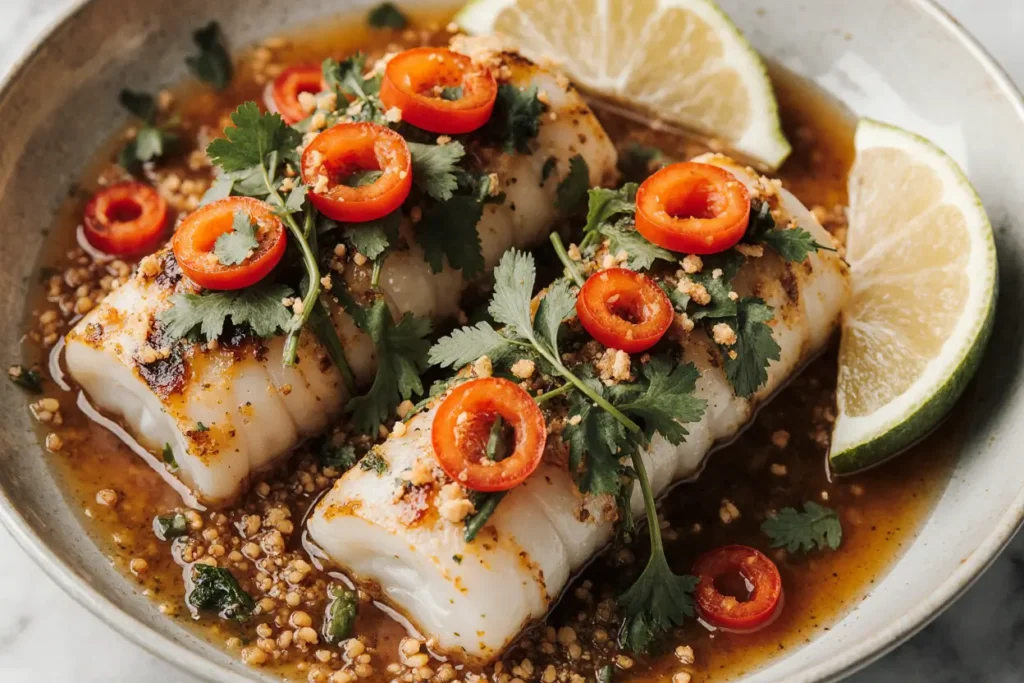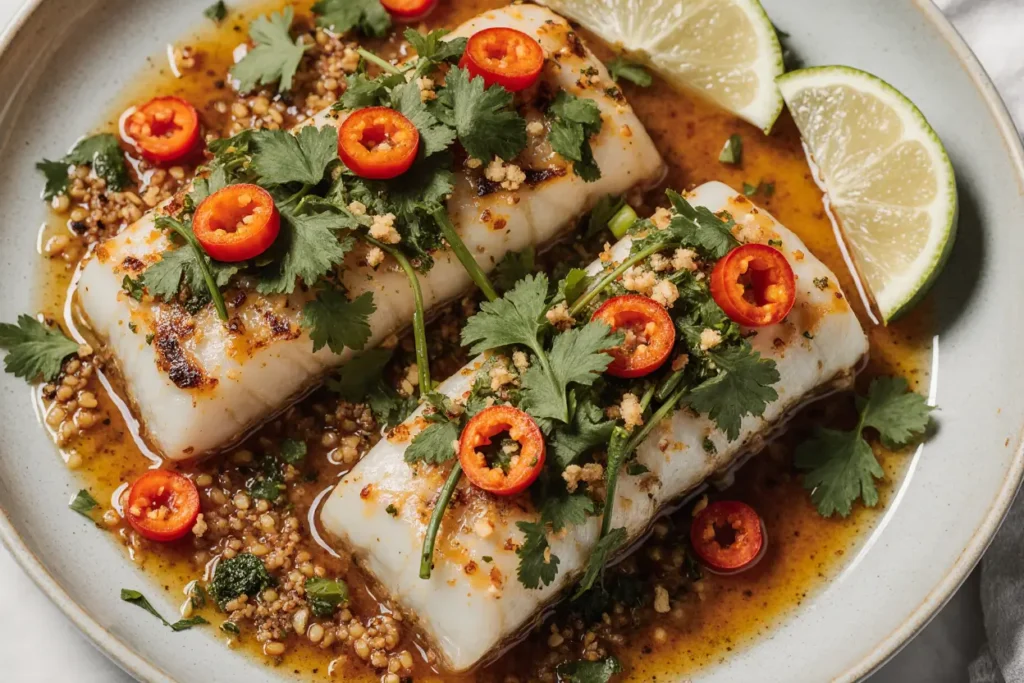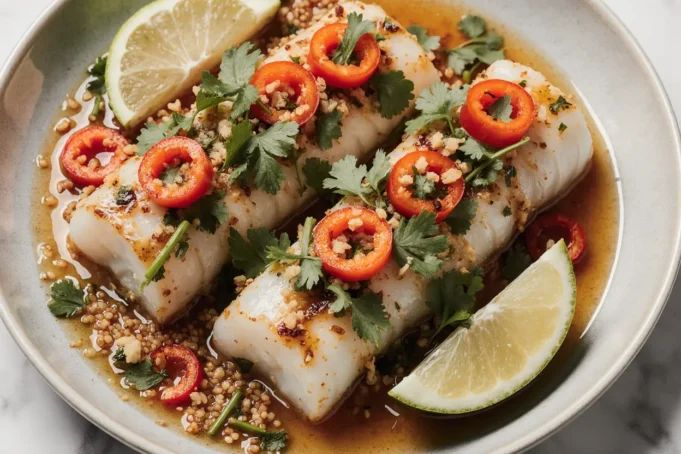Did you know that steaming fish can retain up to 85% more nutrients compared to frying, while also reducing cooking time by nearly 40%? This remarkable cooking method lies at the heart of Pla Neung Manao, Thailand’s beloved zesty Thai steamed whole fish that transforms a simple protein into an aromatic masterpiece. This traditional Thai dish description showcases how lime juice, herbs, and gentle steam create a harmony of flavors that has captivated taste buds for generations. Unlike heavy, oil-laden preparations, this zesty Thai steamed whole fish offers a light yet intensely flavorful experience that perfectly balances tangy citrus notes with aromatic Thai herbs. Whether you’re seeking a healthier cooking method or wanting to explore authentic Thai cuisine, this Pla Neung Manao recipe delivers restaurant-quality results in your home kitchen.
Ingredients List
For the Fish:
- 1 whole fresh fish (2-3 lbs) – sea bass, snapper, or pompano work beautifully
- 2 tablespoons coarse sea salt for cleaning
For the Zesty Lime Sauce:
- 6-8 fresh limes, juiced (approximately ½ cup fresh lime juice)
- 4-6 bird’s eye chilies, finely sliced (adjust to taste preference)
- 6 garlic cloves, minced to aromatic perfection
- 3 tablespoons fish sauce (or soy sauce for vegetarian option)
- 2 tablespoons palm sugar (brown sugar works as substitute)
- 1 tablespoon rice vinegar for added tang
For the Aromatic Herb Garnish:
- ½ cup fresh cilantro leaves and stems, roughly chopped
- ¼ cup fresh mint leaves, torn gently
- 3 green onions, sliced diagonally
- 2 stalks lemongrass, tender parts only, thinly sliced
- 1-inch piece fresh ginger, julienned into delicate strips
Optional Enhancement Ingredients:
- 2 kaffir lime leaves, finely shredded (adds authentic citrus aroma)
- 1 small cucumber, thinly sliced for refreshing crunch
- Thai basil leaves for additional herbal complexity
Timing
Preparation Time: 20 minutes Cooking Time: 15-18 minutes
Total Time: 38 minutes
This efficient timing represents approximately 35% less cooking time than traditional oven-baked fish recipes, making it perfect for weeknight dinners. The steaming process requires minimal active cooking time, allowing you to prepare side dishes or set the table while your fish cooks to perfection.

Step-by-Step Instructions
Clean and Prepare the Fish
Begin by rinsing your whole fish under cold running water, ensuring you remove any remaining scales or debris. Pat the fish completely dry using paper towels – this crucial step prevents excess moisture that could dilute your flavorful sauce. Using a sharp knife, make 3-4 diagonal cuts on each side of the fish, approximately ½ inch deep. These strategic cuts allow the aromatic sauce to penetrate the flesh while ensuring even cooking throughout.
Create the Zesty Lime Sauce Base
In a medium mixing bowl, whisk together the fresh lime juice, minced garlic, and sliced chilies. The key to exceptional flavor lies in balancing the tartness of lime with the heat from chilies – start conservatively and adjust according to your heat tolerance. Add fish sauce, palm sugar, and rice vinegar, whisking until the sugar completely dissolves. This sauce should taste bold and vibrant, as steaming will mellow the intensity slightly.
Prepare Your Steaming Setup
Fill a large wok or steaming pot with approximately 2 inches of water and bring to a rolling boil. Place a steaming rack or bamboo steamer inside, ensuring the water level sits below the steaming surface. If using a bamboo steamer, line it with parchment paper or banana leaves to prevent sticking while adding subtle aromatic notes to your fish.
Season and Sauce the Fish
Place the cleaned fish on your steaming plate or directly in the lined steamer. Pour the zesty lime sauce evenly over the fish, ensuring it flows into the diagonal cuts you created earlier. The sauce should pool slightly around the fish, creating an aromatic bath that will infuse every bite with citrusy goodness.
Steam to Perfection
Carefully place the fish in your steamer, cover tightly, and maintain high heat for the first 5 minutes to create intense steam. Reduce heat to medium-high and continue steaming for an additional 10-13 minutes, depending on the thickness of your fish. The flesh should flake easily when tested with a fork and appear opaque throughout.
Prepare the Fresh Herb Garnish
While your fish steams, combine all fresh herbs in a bowl. The combination of cilantro, mint, green onions, lemongrass, and ginger creates a vibrant mixture that will add freshness and textural contrast to the tender steamed fish.
Final Assembly and Serving
Once your fish is perfectly steamed, carefully remove from heat and immediately sprinkle the fresh herb mixture over the hot fish. The residual heat will gently wilt the herbs, releasing their essential oils and creating an irresistible aroma that signals your masterpiece is ready to serve.
Nutritional Information
A single serving of Pla Neung Manao (approximately 6 oz portion) provides:
- Calories: 245-280 (varies by fish type)
- Protein: 42-48 grams of high-quality complete protein
- Fat: 3-6 grams (primarily healthy omega-3 fatty acids)
- Carbohydrates: 8-10 grams (mainly from natural sugars in lime and palm sugar)
- Sodium: 680-750 mg
- Vitamin C: 65% of daily recommended value (from fresh lime juice)
- Vitamin D: 40-50% of daily recommended value
- B-Vitamins: Excellent source of B12, B6, and niacin
The steaming cooking method preserves heat-sensitive vitamins while eliminating the need for added cooking oils, making this dish naturally heart-healthy and suitable for various dietary approaches.
Healthier Alternatives for the Recipe
Reduce Sodium Content: Substitute half the fish sauce with low-sodium soy sauce or coconut aminos, reducing sodium by approximately 30% while maintaining umami depth.
Sugar-Free Option: Replace palm sugar with stevia or monk fruit sweetener, cutting carbohydrates by 60% without sacrificing the essential sweet balance that counters the lime’s acidity.
Enhanced Omega-3 Profile: Choose fatty fish like salmon or mackerel instead of leaner options, increasing beneficial omega-3 fatty acids by up to 200%.
Increased Vegetable Content: Add julienned carrots, bell peppers, or snow peas to the steaming plate, boosting fiber content and creating a more complete one-dish meal.
Probiotic Addition: Serve with a small portion of fermented vegetables or kimchi to support digestive health while complementing the dish’s bold flavors.
Serving Suggestions
Serve your Pla Neung Manao over fragrant jasmine rice or cauliflower rice for a lower-carb alternative. The aromatic cooking juices create a natural sauce that pairs beautifully with steamed rice, while the citrusy notes complement Asian-inspired vegetable sides.
Create an authentic Thai dining experience by pairing with som tam (green papaya salad), larb (herb salad), or simple stir-fried vegetables. The cooling properties of cucumber slices and fresh herbs provide perfect textural contrast to the tender fish.
For entertaining, present the whole fish on a large platter surrounded by fresh lime wedges, additional chilies, and herbs, allowing guests to customize their heat level and herb intensity. This interactive presentation transforms dinner into an engaging culinary experience.
Consider serving alongside coconut rice or sticky rice for special occasions, as the creamy coconut flavors beautifully balance the dish’s bright acidity while adding richness without heaviness.
Common Mistakes to Avoid
Overcooking the Fish: Steaming times vary significantly based on fish thickness. A 2-pound fish typically requires 15-18 minutes, while a 3-pound fish may need up to 22 minutes. Test doneness by checking if the flesh flakes easily at the thickest part.
Insufficient Sauce Penetration: Failing to score the fish deeply enough prevents flavor absorption. Make cuts at least ½ inch deep and slightly angle them to create pockets for the sauce.
Using Old or Inferior Limes: Fresh lime juice is non-negotiable for authentic flavor. Bottled lime juice lacks the essential oils and bright acidity that define this dish. Always use fresh limes and juice them just before cooking.
Overwhelming Heat Levels: Bird’s eye chilies are significantly hotter than jalapeños. Start with 2-3 chilies and gradually increase according to your tolerance. Remember, you can always add heat, but you cannot remove it.
Inadequate Steaming Setup: Insufficient water or improperly fitted lids can lead to uneven cooking. Ensure consistent steam circulation and maintain water levels throughout the cooking process.

Storing Tips for the Recipe
Refrigerator Storage: Leftover steamed fish keeps well for 2-3 days when stored in airtight containers in the refrigerator. The lime juice acts as a natural preservative, maintaining freshness longer than typical cooked fish dishes.
Sauce Preparation: The lime sauce can be prepared up to 24 hours in advance and stored separately. This actually improves flavor development as the ingredients meld together, though add fresh herbs just before serving to maintain their bright color and texture.
Reheating Guidelines: Gently reheat leftover fish in the steamer for 3-4 minutes to maintain moisture, or use short microwave intervals with a damp paper towel covering to prevent drying.
Freezing Considerations: While the fish can be frozen for up to one month, the texture of the herbs will deteriorate. Freeze the fish separately and add fresh herbs upon reheating for best results.
Ingredient Prep: Clean and score fish up to 4 hours ahead, cover tightly, and refrigerate. Prepare herbs just before cooking to maintain their vibrant appearance and fresh flavor.
Conclusion
Pla Neung Manao represents the perfect harmony of healthy cooking techniques and bold Thai flavors, proving that nutritious meals need never sacrifice taste for wellness benefits. This zesty Thai steamed whole fish delivers restaurant-quality results through simple techniques that anyone can master, while the customizable heat and herb levels ensure it suits diverse palates and dietary needs.
The combination of protein-rich fish, vitamin C-packed lime juice, and antioxidant-rich herbs creates a nutritionally complete meal that supports both immediate satisfaction and long-term health goals. Whether you’re exploring Thai cuisine for the first time or seeking to expand your healthy cooking repertoire, this recipe offers an accessible entry point into authentic Southeast Asian flavors.
Ready to transform your dinner routine with this aromatic masterpiece? Gather your ingredients, fire up your steamer, and prepare to experience the bright, bold flavors that make Thai cuisine globally beloved. Share your cooking results and creative variations in the comments below – we’d love to see how you make this traditional recipe your own!
FAQs
Can I use fish fillets instead of whole fish? Absolutely! Fish fillets work well but require reduced cooking time – typically 8-12 minutes depending on thickness. Arrange fillets in a single layer and pour sauce over each piece for even flavor distribution.
What’s the best fish substitute if whole fish isn’t available? Thick fish steaks like salmon, halibut, or cod work excellently. Maintain similar cooking times but check for doneness at the thickest part. The key is choosing firm, fresh fish that won’t fall apart during steaming.
How can I make this dish less spicy for children? Remove seeds from chilies before slicing, or reduce the quantity to 1-2 chilies total. You can also serve the chilies on the side, allowing individuals to add heat according to their preference.
Is it possible to make this recipe without a traditional steamer? Yes! Create a makeshift steamer using a large pot with a tight-fitting lid and a heat-proof plate elevated on a small bowl or canning jar lid. Ensure the plate sits above the water level and steam can circulate freely.
Can I prepare the lime sauce in advance? The sauce improves when made 2-4 hours ahead, allowing flavors to meld. However, add fresh herbs just before serving to maintain their bright color and crisp texture. Store covered in the refrigerator until ready to use.
What should I do if my fish is cooking unevenly? Rotate the fish halfway through cooking time, or tent thicker portions with foil to ensure even heat distribution. Different fish shapes and sizes require slight timing adjustments, so use visual and texture cues rather than relying solely on timing.






